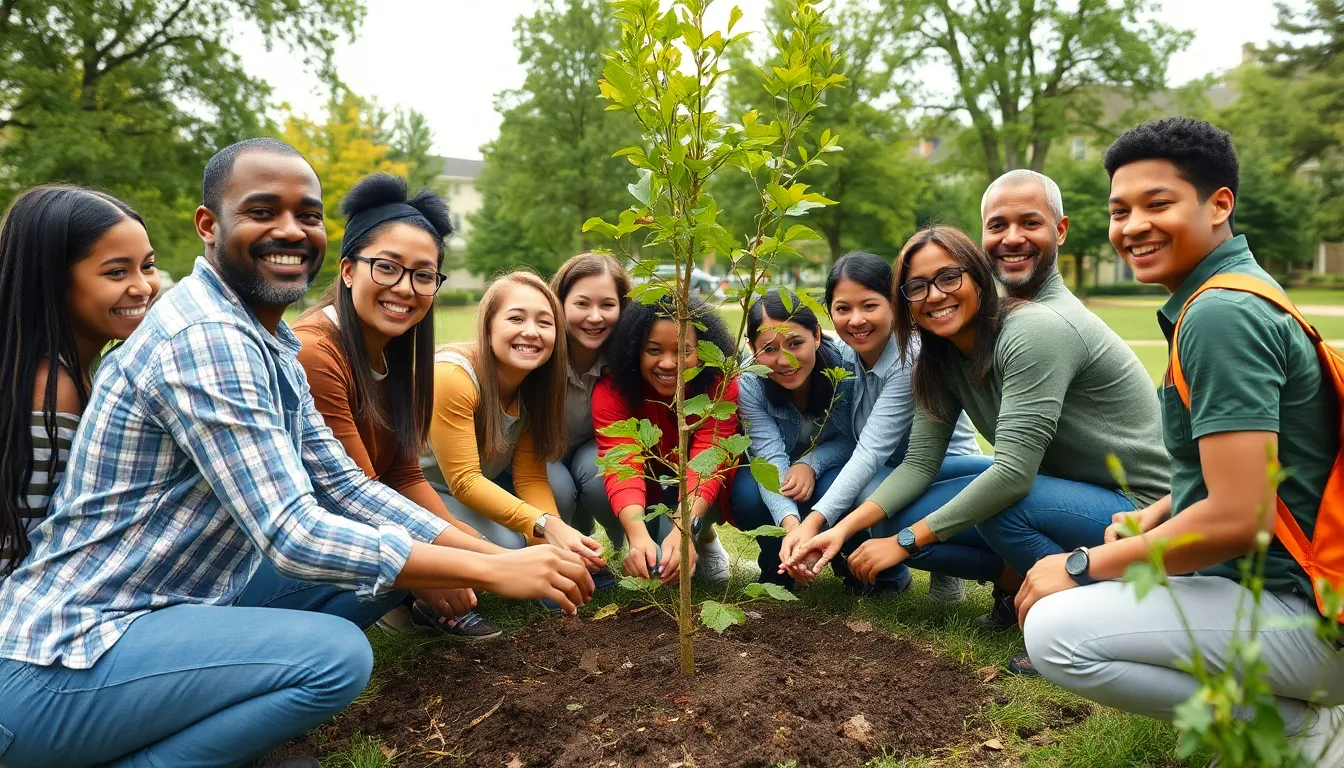In a world where the environment often takes a backseat to convenience, community environmental projects are like the superheroes we didn’t know we needed. They swoop in, armed with shovels and recycling bins, ready to tackle pollution and restore green spaces. These grassroots initiatives not only beautify neighborhoods but also foster a sense of belonging that even your favorite coffee shop can’t compete with.
Imagine a community coming together to plant trees, clean up parks, or start a community garden. It’s not just about saving the planet; it’s about creating connections and having a good time while doing it. Who knew saving the Earth could be as fun as a weekend barbecue? Join the movement and discover how these projects can transform not just the environment, but also the spirit of the community.
Table of Contents
ToggleOverview of Community Environmental Projects
Community environmental projects play a crucial role in addressing local ecological challenges. These initiatives are often driven by residents who recognize the need for cleaner air, greener spaces, and healthier ecosystems. By organizing tree planting efforts, communities can significantly increase local biodiversity, helping to restore habitats for various species. Park clean-ups not only enhance public spaces but also raise awareness about littering and its environmental impact.
Community gardening serves as another vital component. Shared gardens allow residents to cultivate fruits and vegetables while promoting sustainable practices such as composting and organic farming. Participation in these projects often fosters a sense of ownership and pride among community members. Collaboration becomes key, as individuals work together to achieve common environmental goals.
Educational workshops often accompany these initiatives, providing residents with valuable skills and knowledge about conservation techniques and environmental science. Increased community involvement leads to a deeper understanding of local environmental issues. This collective effort enriches social ties, creating a supportive network that bolsters community spirit.
Funding for community environmental projects typically comes from local government, non-profit organizations, or community fundraising efforts. Such financial support enables a project’s expansion, allowing it to reach more participants. Many successful projects have secured grants specifically targeting environmental sustainability, ensuring their longevity and effectiveness.
Through community engagement, these projects empower individuals to make tangible changes in their surroundings. Building a healthier environment becomes a shared responsibility that cultivates collective action within neighborhoods. Ultimately, these grassroots initiatives lead to lasting enhancements for both the environment and the community.
Importance of Community Engagement

Community engagement drives participation in environmental initiatives. Active involvement motivates residents to connect with their surroundings in meaningful ways.
Building Local Ownership
Ownership fosters a sense of pride among community members. Residents who participate in projects like tree planting develop a personal stake in their environment. Grassroots efforts encourage collaboration and investment in local spaces. By creating a sense of belonging, these initiatives enhance dedication to maintaining and improving local areas. Individuals often feel responsible for the transformation, leading to long-term commitment. Collective action can transform neglected spaces into vibrant community landmarks.
Enhancing Sustainability
Sustainability initiatives thrive on community participation. Engaging locals in recycling events promotes responsible waste management practices. Projects that encourage urban gardening support food security and biodiversity while providing fresh produce. Residents who learn about sustainable practices can influence others, multiplying the positive impact. Workshops on conservation techniques deepen understanding and empower action. Involvement in community projects helps build resilient ecosystems that benefit future generations.
Types of Community Environmental Projects
Community environmental projects come in various forms, each addressing specific ecological and social needs. These initiatives engage residents and foster a sense of responsibility towards their environment.
Urban Greening Initiatives
Urban greening initiatives enhance city landscapes through planting trees, establishing green roofs, and creating community parks. Trees improve air quality and provide shade, while green roofs offer insulation for buildings. Community parks serve as gathering spaces, promoting physical activity and interaction among residents. Engaging residents in these efforts cultivates a deeper connection to nature and instills pride in local areas. Educational activities often accompany these projects, teaching participants about the benefits of biodiversity and native plant species. Collaborative planting events can lead to vibrant, green neighborhoods that significantly improve community well-being.
Waste Management Programs
Waste management programs focus on promoting responsible disposal and recycling practices within communities. These initiatives often include organized clean-up days, recycling drives, and educational sessions on reducing waste. Communities can see rapid improvements in cleanliness and environmental health when residents actively participate. Programs that emphasize composting also help divert organic waste from landfills, benefiting soil quality and reducing methane emissions. Collaboration among local organizations and businesses strengthens these efforts, providing resources and support for maximizing impact. By raising awareness around waste reduction, these programs encourage sustainable habits among participants, leading to long-term changes.
Challenges Faced by Community Environmental Projects
Community environmental projects encounter several significant challenges that can impact their success and sustainability.
Funding and Resources
Funding and resource acquisition present major hurdles for community environmental projects. Many initiatives rely on grants from local governments or non-profits, which can be unpredictable and limited in availability. Resource allocation often requires meticulous planning, as project organizers navigate increasing competition for funds. Sustainable funding strategies, such as community fundraising events, can enhance financial stability. Strengthening partnerships with local businesses may also provide necessary resources, from materials to volunteer support. Establishing clear budgets and demonstrating measurable outcomes can attract additional financial backing. Successful projects often show how funds directly impact environmental quality and community welfare.
Community Participation
Community participation remains crucial for the success of environmental projects. Engaging residents effectively fosters ownership but can be challenging to achieve. Some individuals may feel disconnected or unaware of ongoing initiatives, leading to low turnout. To encourage participation, project leaders can host outreach events showcasing benefits, making environmental improvements more tangible. Building a strong online presence helps keep the community informed and involved, leveraging social media to invite feedback and participation. Diverse outreach strategies, such as multilingual materials, can attract various demographics. Strong community bonds, fostered through collaboration, enhance motivation and commitment to future initiatives.
Successful Case Studies
Community environmental projects demonstrate their effectiveness through various successful case studies. These examples highlight local initiatives that have made a significant impact.
Project in City X
In City X, residents launched a tree-planting initiative, achieving remarkable results. Hundreds of trees were planted along public streets and parks, enhancing air quality and biodiversity. Local schools participated, allowing students to understand the importance of trees in their environment. Collaboration among community members strengthened bonds, leading to ongoing maintenance of the planted trees. This project also inspired neighboring communities, sparking similar initiatives across the region.
Project in Town Y
Town Y initiated a community gardening program that transformed vacant lots into productive green spaces. Participants grew vegetables and herbs, improving food security while promoting sustainable practices. Workshops on composting and organic gardening educated residents, enhancing their environmental knowledge. Families gathered to share ideas and harvest, reinforcing community ties. The program received support from local businesses and nonprofits, ensuring its sustainability and effectiveness. As a result, Town Y experienced increased participation in future environmental projects.
Community environmental projects play a crucial role in shaping healthier and more vibrant neighborhoods. By promoting collaboration among residents, these initiatives foster a strong sense of belonging while addressing local ecological challenges. The positive impact of activities like tree planting and community gardening extends beyond environmental benefits, creating lasting connections among participants.
As communities engage in these efforts, they not only improve their surroundings but also cultivate a culture of sustainability and responsibility. The potential for transformation is immense, with each project serving as a catalyst for further involvement and awareness. Embracing these grassroots initiatives can lead to a brighter future for both the environment and the community as a whole.


